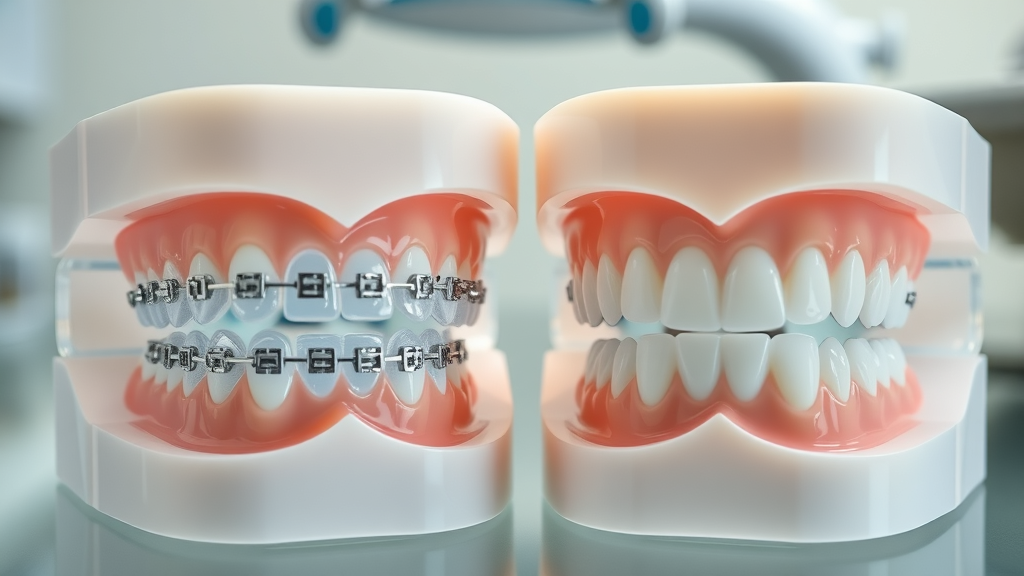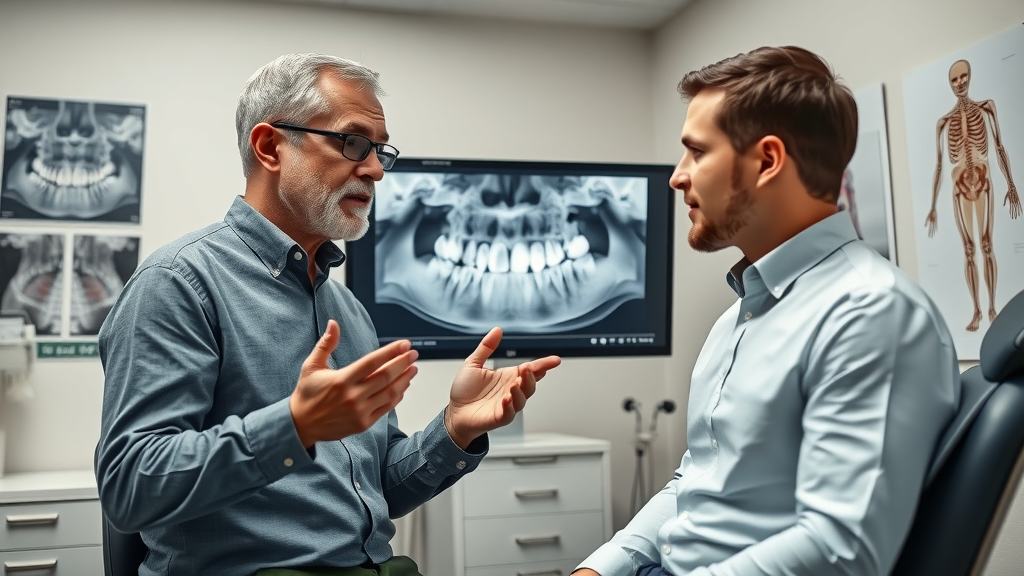Ever wondered if those nearly invisible clear aligners can straighten teeth just as well as classic metal braces? With more people seeking discreet options for a better smile, it's no surprise this question is on everyone's mind. As orthodontic technology keeps advancing, the choice between clear aligners and metal braces is more relevant than ever. This guide dives deep to reveal the facts, pros, cons, and real-world success you need to feel confident about your orthodontic journey—no matter your age.

- The science behind clear aligners and metal braces effectiveness
- Key differences in treatment, maintenance, and results
- How to choose between clear aligners versus metal braces for your unique dental needs
- Practical advice backed by orthodontic experts
Curious If Clear Aligners Are as Effective as Metal Braces? Start With the Facts
When choosing between clear aligners and metal braces , patients want the best results for their unique smiles. The main question— are clear aligners as effective as metal braces? —touches on straightening crooked teeth, correcting bite issues, and ensuring long-term oral health. It’s important to recognize that both treatments are designed for orthodontic correction , but they use different technologies and approaches.
Metal braces combine brackets and wires to gradually guide teeth into their ideal position. On the other hand, clear aligners (like Invisalign) are custom-made trays that fit your teeth snugly, using gentle, constant pressure to move teeth overtime. Some cases need just a few months of aligners; other, more complex issues require the precision of classic braces. Let’s dig into the key facts so you can make an informed decision on your best path to an aligned, healthy smile.
Clear Aligners vs. Metal Braces: Fundamental Differences Explored
What Are Clear Aligners and Metal Braces? Definitions and Technology
Clear aligners are transparent, removable plastic trays crafted from high-tech materials designed to fit your teeth at each stage of your treatment plan. You’ll receive several sets of aligners, each worn for a couple of weeks, gradually moving your teeth towards their ideal position. Aligners are virtually invisible, making them especially popular with adults and teens who value aesthetics.
Metal braces , in contrast, use stainless steel brackets bonded to the teeth, connected by wires and sometimes rubber bands to apply continuous pressure. Adjustments are made at periodic office visits. While these may be more noticeable than metal alternatives like ceramic brackets , metal braces are reliable and time-tested, offering the most control for severe or complex orthodontic problems .

Historical Evolution: From Traditional Metal Braces to Modern Clear Aligners
The journey from traditional metal braces to today’s clear aligner systems highlights decades of innovation in orthodontic care. Metal braces have been in use for over a century, constantly improving with better materials, bracket designs, and enhanced comfort. They’re considered the gold standard for comprehensive bite correction and severe crowding.
Clear aligners made their debut in the late 1990s, offering a new level of convenience and discretion. Originally suited for only mild to moderate cases, technological advancements in digital imaging , 3D printing , and material science now allow clear aligners to treat an expanding range of orthodontic issues . The ability to remove aligners has further revolutionized oral hygiene and lifestyle compatibility.
Are Clear Aligners as Effective as Metal Braces? Comparing Orthodontic Outcomes
Clinical Effectiveness of Clear Aligners Versus Metal Braces: What Recent Studies Show
Numerous clinical studies confirm that clear aligners can successfully treat a broad spectrum of orthodontic issues , particularly mild to moderate cases such as spaced teeth, mild crowding, and certain bite concerns. Patients using clear aligners for straightforward cases often achieve results comparable to those with metal braces —sometimes even faster.
However, research indicates that metal braces still outshine aligners for managing severe malocclusions or cases requiring complex tooth movement (like rotating teeth or correcting significant vertical discrepancies). For most teenagers and adults with predictable alignment needs, clear aligners provide effective, discreet results. But in complex cases, orthodontists may recommend sticking with traditional braces for maximum control.
Which Dental Issues Require Metal Braces, Not Clear Aligners?
While clear aligners are effective for many, certain orthodontic challenges demand the precision of metal braces or even traditional metal braces . Complicated bite problems (underbites, overbites, and crossbites), extreme rotations, and large tooth movements often respond better to brackets and wires. That’s because metal braces can use additional attachments and rubber bands to move teeth in ways that aligners alone cannot.
If you have impacted teeth, severe gaps, or require jaw correction, your treatment plan may include full-fledged metal braces or even hybrid approaches that combine aligners and braces. To ensure lasting results and aligned teeth , your orthodontist will conduct a thorough assessment before recommending the right solution for your oral health .
| Category | Clear Aligners | Metal Braces |
|---|---|---|
| Straightforward cases | High | High |
| Complex tooth movement | Moderate | High |
| Treatment time | Potentially less | Normal |
| Aesthetic appeal | Excellent | Poor |
| Cost range | Moderate-High | Moderate |
Advantages of Clear Aligners Over Metal Braces
- Enhanced aesthetics and self-confidence
- Removability and ease of maintaining oral hygiene
- Fewer office visits

Clear Aligner Comfort Factors: What Sets Them Apart from Traditional Metal Braces?
Clear aligners stand out for being virtually invisible and minimizing day-to-day discomfort. Without wires or metal brackets , there’s less irritation against cheeks and lips. Many patients adjust quickly, with little trouble eating or speaking—something harder to achieve for those who wear braces .
Because aligners are removable , maintaining excellent oral hygiene is far easier. You can brush and floss thoroughly without maneuvering around brackets and wires, reducing the risk of cavities and gum problems. Plus, aligners don’t come with dietary restrictions: just take them out for meals, then pop them back in. This freedom is a major draw for many busy adults and image-conscious teens.
"Clear aligners have transformed orthodontic care for adults seeking a discreet smile solution without sacrificing results.” — Dr. Jenna Brooks, Orthodontist
Limitations and Considerations With Clear Aligners vs. Traditional Braces
Situations Where Metal Braces Are Preferable: Complex Movements and Compliance
There are circumstances where metal braces offer clear advantages. If your treatment requires precise control of tooth movement, complex adjustments, or the use of elastics and appliances for jaw alignment, traditional metal braces are typically more suitable. In addition, compliance is crucial for aligner success— aligners must be worn 20-22 hours per day to deliver results.
Some patients, especially children or those prone to misplacing things, may benefit from fixed appliances. With brackets and wires bonded in place, there’s no risk of losing a tray or forgetting to wear it. Thus, for advanced or surgical cases and those at risk of inconsistent wear, metal braces remain the orthodontist’s tool of choice.

Potential Drawbacks of Clear Aligners: What Patients Should Know
While the benefits are appealing, clear aligners do have limitations. Not all dental problems can be treated with aligners alone. They may not always be suitable if you have severe misalignment, pronounced bite problems, or teeth that are particularly stubborn to move.
Additionally, because aligners are removable , patients must be diligent about wearing them as prescribed. Skipping a day or two can set back progress. There’s also a learning curve to speaking at first and the risk of losing aligners during meals. Finally, insurance coverage can vary, and costs can be slightly higher than metal braces , depending on individual cases.
Choosing Between Clear Aligners and Metal Braces: Key Factors to Consider
- Age and stage of dental development
- Severity of misalignment
- Lifestyle priorities (appearance, maintenance)
- Budget and insurance considerations
Recommendations by Orthodontic Specialists: Who is the Best Candidate for Each Option?
Orthodontic experts recommend clear aligners for patients with mild to moderate orthodontic issues who value aesthetics and are responsible enough to follow instructions. Teenagers and adults with busy schedules find aligners convenient due to fewer office visits and easy maintenance. Those with straightforward alignment goals should expect results comparable to traditional braces.
Conversely, metal braces are best for young patients, those with severe dental complications, or anyone needing long-term, complex orthodontic treatment . Your orthodontist will tailor a treatment plan based on X-rays, digital impressions, and your own preferences, ensuring your teeth not only look straight but function optimally for years to come.

Clear Aligners, Metal Braces, or Traditional Braces? Finding Personalized Solutions
Case Studies: Real-life Results With Clear Aligners and Metal Braces
Consider Anna, a college student with moderate crowding who used clear aligners and finished treatment in 12 months. The trays were virtually invisible, and she maintained her busy lifestyle without dietary restrictions. Her dentist noted that her diligent wear time was a key factor in her success.
Compare this to Jake, a high school junior with a severe overbite and rotated teeth. He was prescribed metal braces that incorporated rubber bands and appliances, ensuring the necessary tooth movement and bite correction. His result? A beautifully aligned smile after 18 months, and a newfound confidence.
Combining Treatments: When Clear Aligners and Metal Braces Work Together
In select cases, orthodontists may use a hybrid approach. For example, a patient might start with metal braces for rapid alignment of complex bites, then switch to clear aligners for finishing touches and refinements. This allows for optimal control, efficiency, and comfort during different stages of the correction process.
Combining treatments ensures each patient receives the tools best suited for their specific orthodontic issues . Trust your orthodontist to select the right combination for you, blending timeless results with modern convenience.
People Also Ask About Are Clear Aligners as Effective as Metal Braces?
Do clear aligners work as good as braces?
Most straightforward orthodontic cases can be treated just as effectively with clear aligners as with traditional metal braces. However, complex or severe malocclusions often respond better to metal braces, which offer more control for specific tooth movements.
Are clear braces as effective as metal?
Clear braces (ceramic braces) are similar to metal braces in terms of effectiveness but are less visible. Both options can handle complex alignment issues competently; the choice often comes down to appearance and patient preference.
Which is better, metal braces or aligners?
Metal braces are superior for complex cases demanding precise tooth movement, while aligners offer convenience, aesthetics, and comfort for milder to moderate corrections.
Do clear retainers work better than metal?
Clear retainers are not designed to move teeth like braces or aligners but are intended to maintain teeth in their corrected positions. Effectiveness depends on compliance and individual dental needs.
FAQs: Are Clear Aligners as Effective as Metal Braces?
Is treatment time shorter with aligners?
In many mild to moderate cases, treatment time with clear aligners can be equal to or even slightly shorter than with traditional metal braces. Compliance—wearing the aligners for the recommended hours daily—is essential for speedy results. For more complex movements, metal braces may work faster due to their precise control.
How do aligners work compared to traditional braces?
Aligners use a series of custom-fit trays to gently move teeth, made possible by advanced imaging and computer modeling. Traditional braces rely on metal brackets, wires, and periodic adjustments. Both systems gradually shift teeth to their ideal positions, but aligners offer added discretion and removability during meals and dental hygiene.
Are clear aligners suitable for teens?
Yes! Today’s clear aligners are a practical and popular choice for responsible teens with mild to moderate orthodontic problems. Manufacturers even offer aligners with wear indicators to help track compliance. However, teens needing significant correction or less likely to wear their aligners as instructed may benefit from traditional braces.
Expert Takeaways on Are Clear Aligners as Effective as Metal Braces?
- Aligners are effective for mild to moderate misalignments
- Metal braces remain crucial for severe, complex corrections
- A professional consultation determines the best solution for each patient
Ready for the Next Step in Your Smile Journey?
Want more expert-backed answers about braces, Invisalign, and local orthodontic care? Subscribe to Grand Strand Smile Spotlight and stay ahead of your smile journey.
Take the first step by consulting a qualified orthodontist and discover your path to a healthier, more confident smile—whether you choose clear aligners or metal braces.
When considering orthodontic treatments, it’s essential to understand the effectiveness of different options. The article “A comparison of treatment effectiveness between clear aligner and fixed appliance therapies” provides a comprehensive analysis, indicating that while both clear aligners and traditional braces are effective, aligners may not be as proficient in achieving adequate occlusal contacts and controlling teeth torque. ( pmc.ncbi.nlm.nih.gov ) Additionally, the “Clear aligners” entry on Wikipedia offers an overview of clear aligners, noting their suitability for mild to moderate cases and highlighting their advantages in terms of aesthetics and comfort. ( en.wikipedia.org ) For those exploring orthodontic options, these resources offer valuable insights into the comparative effectiveness of clear aligners and metal braces.
 Add Row
Add Row  Add
Add 




Write A Comment